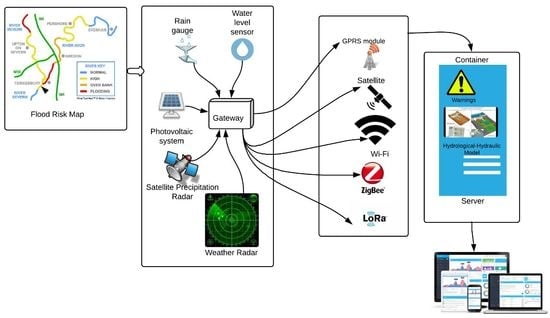Real-Time Early Warning System Design for Pluvial Flash Floods—A Review
Abstract
:1. Introduction
2. Pluvial Flash Flood Intensity
2.1. Climate Change
2.2. Urbanization
2.3. Soil Characteristics
2.4. Basin Characteristics
3. Early Warning System Basic Architecture
- Historical background
- Geographical aspects
- Environmental and physical aspects
- Socio-cultural aspects
- Economic aspects
- Are the hazards and the vulnerabilities well known?
- What are the patterns and trends in these factors?
- Are risk maps and data widely available?
- First, the initial data processing, establishment of the hydrological model to predict runoff, probability analysis and elaboration of a flood risk map is performed.
- Second, interviews, discussion groups and workshops are conducted with the community at risk to determine vulnerability, taking into account community perceptions and historical records.
- Are the right parameters being monitored?
- Is there a scientific basis for making forecasts?
- Can accurate and timely warnings be generated?
- Do warnings reach all those at risk?
- Are the risk and warnings understood?
- Is the warning information clear and usable?
- Dissemination of warnings through organizations or leaders
- Sending warnings through multiple credible sources
- Periodic and constant warnings
- Scientifically certified warnings
- Having information regarding their preparation
- A communication plan, evacuation strategies
- First-Aid and disaster knowledge
- Financial resilience
- Preparedness behaviours
- (1)
- Places to seek medical attention (92.2%)
- (2)
- Evacuation routes (85.2%)
- (3)
- Shelter information (84.8%)
- (4)
- Details of the disaster (67.4%)
- (5)
- Missing persons (65.2%)
- (6)
- Victims (45.2%)
- (1)
- Perceptions and understandings of flash flood risks
- (2)
- Perceptions and interpretations of flash flood forecasts, warnings, and other alerts
- (3)
- Protective decision making in response to flash flood warnings
- Institutional and social conditions that must be fulfilled to ensure timely decision-making regarding the warnings should be as follows:
- Alert dissemination and communication
- Clarity regarding responsibilities in case of warning
- Preparing authorities and communities to respond to the disaster
- The involvement of local communities and authorities in the design of EWS increases the effectiveness of the entire early warning process and thus leads to a greater and better response to an alert.
4. Real-Time EWS for Pluvial Flash Floods
4.1. Florida, United States
- The Ultrasonic Water Level Monitoring module uses an ultrasonic sensor to measure water level and it is connected to a data acquisition board and this, in turn, is connected to a wireless system. The wireless system is an MDA300CA unit manufactured by Crossbow Technology (Milpitas, CA, USA) and uses IEEE 802.15 standard to send the information to the data processing module.
- The Network Video Recording Module is composed of a group of cameras installed at main intersections. Cameras provide traffic monitoring information in video and images. This system includes four Redeye Z205 network cameras and can be connected via Ethernet to the data processing module. Each camera has an IP address assigned to which users will have access from any Web searcher.
- The Data Processing Module combines all sources of information. This module provides three types of information: raw data, predicted data, and video information. The raw data is the information obtained by the sensors, while the predicted data are obtained through mathematical models. All of this must be accessible online.
4.2. Barranquilla, Colombia
- The wireless sensor network has six nodes and each node has a temperature, humidity and atmospheric pressure sensor connected to a mote (Waspmote from Libelium, Zaragoza, Spain) and powered by a photovoltaic system. This system was used by Ramírez-Cerpa et al. [73] to determine through an analysis the influence of the variation of these atmospheric variables in the formation of precipitations that cause flash floods in the city of Barranquilla. Information obtained via nodes is sent to a server using Zigbee technology with the XBee-PRO ZB (S2) radio module [74]. This module uses ZigBee technology under the IEEE 802.15.4 standard to communicate with other nodes and with the base station. Previously, in Caicedo-Ortíz et al. [75], a test was conducted to verify the transmission range of the Waspmote pro. It established an efficient communication between the transmitter node and the receiving node at a distance of 1000 m with line of sight.
- A server receives the data from the wireless sensor network and, through a Web and mobile application, gives information to end-users.
4.3. Manila, Philippines
- The Electronic Instrumentation has a ground-based pressure sensor and a tipping bucket rain gauge connected to the data logger and powered by a photovoltaic system. The obtained information is sent through a General Packet Radio Service (GPRS) module to a server. Two nodes were installed on two nearby streets (Earnshaw and San Diego) on Boulevard Spain, Manila.
- The Server receives the data and processes it to provide real-time information. A Web application provides real-time information, historical data and flood data to users. Likewise, a mobile application shows the real-time variation of flash floods in the streets so that users can adjust their routes and travel schedules. Figure 4 illustrates the urban flood monitoring system for Manila (Philippines) Metro project.
4.4. Nakhon Si Thammarat, Thailand
- The Remote Site. The monitoring section contains 15 remote devices located around the Nakhon Si Thammarat flood risk zone. A tipping bucket rain gauge was used to measure the amount and intensity of the rain. These remote devices use an ultrasonic Doppler instrument called STARFLOW (Unidata, Perth, Australia) to measure water level and velocity. Since the STARFLOW equipment is very sensitive to fluctuations in water velocity in the channel, the average velocity was used in a time interval rather than raw measurement data. The STARFLOW unit is connected to the GPRS Data Unit (GDU) and sends the information every 10 min to the control centre
- The Control Center has a server that contains the historical database, processes in real time the information and displays it through a WEB application. End-users can access this system through the Internet or mobile devices. The alert messages are also sent via text messages (SMS), FAX and email to the community.
4.5. Mayagüez, Puerto Rico
4.6. Barcelona, Spain
5. Discussion
5.1. Forecasting Process
5.2. Dissemination Process
- -
- Probability of detection
- -
- Accuracy: Forecast flood levels compared with measured flood levels.
- -
- Reliability: Flood-hit, miss and false alarm rates.
- -
- Probability (i.e., uncertainty): Amount or percentage of certainty/uncertainty associated with the forecast
- -
- Time range ahead of the flood: How far ahead in time a forecast can be made
- -
- Timeliness: Warning lead time
- -
- Spatial resolution: The smallest area for which a forecast can be made
- -
- Warning information: Recipients’ assessments of the degree to which the warning provided them with the flood information they needed.
- -
- Satisfaction with the flood warning service: Levels of satisfaction among those for whom flood warnings were/should have been provided.
- -
- Damage Reduction: The amount of flood damage saved by the warning.
- -
- Protection of life and limb: The assessed number of lives and injuries avoided by the warning.
- -
- Benefit–cost ratio: The ratio of the assessed benefits and costs of providing a flood warning.
6. Conclusions
Funding
Acknowledgments
Conflicts of Interest
References
- Kundzewicz, Z.W. Non-structural flood protection and sustainability. Water Int. 2002, 27, 3–13. [Google Scholar] [CrossRef]
- Singh, P.; Sinha, V.S.P.; Vijhani, A.; Pahuja, N. Vulnerability assessment of urban road network from urban flood. Int. J. Disaster Risk Reduct. 2018, 28, 237–250. [Google Scholar] [CrossRef]
- Birkmann, J.; von Teichman, K. Integrating disaster risk reduction and climate change adaptation: Key challenges—Scales, knowledge, and norms. Sustain. Sci. 2010, 5, 171–184. [Google Scholar] [CrossRef]
- International Strategy for Disaster Reduction (ISDR). Emerging Challenges for Early Warning Systems in context of Climate Change and Urbanization. Available online: http://www.preventionweb.net/ files/15689_ewsincontextofccandurbanization.pdf (accessed on 9 August 2017).
- Chaumillon, E.; Bertin, X.; Fortunato, A.B.; Bajo, M.; Schneider, J.-C.; Dezileau, L.; Walsh, J.P.; Michelot, A.; Chauveau, E.; Créach, A.; et al. Storm-induced marine flooding: Lessons from a multidisciplinary approach. Earth Sci. Rev. 2017, 165, 151–184. [Google Scholar] [CrossRef]
- The University Corporation for Atmospheric Research. Flash Flood Early Warning System Reference Guide; The University Corporation for Atmospheric Research: Boulder, CO, USA, 2010. [Google Scholar]
- National Weather Service. Flood Safety Awareness Week: Flood Hazards. 2017. Available online: http://www.weather.gov/aly/fldsafetyWednesday (accessed on 7 July 2017).
- Ministère de l’Écologie and du Développement Durable et de l’Énergie. Submersion Marine; Ministère de l’Écologie and du Développement Durable et de l’Énergie: Paris, France, 2016.
- The World Bank; Jha, A.K.; Bloch, R.; Lamond, J. Cities and Flooding A Guide to Integrated Urban Flood Risk Management for the 21st Century; The World Bank: Washington, DC, USA, 2012. [Google Scholar]
- Alfieri, L.; Cohen, S.; Galantowicz, J.; Schumann, G.J.-P.; Trigg, M.A.; Zsoter, E.; Prudhomme, C.; Kruczkiewicz, A.; de Perez, E.C.; Flamig, Z.; et al. A global network for operational flood risk reduction. Environ. Sci. Policy 2018, 84, 149–158. [Google Scholar] [CrossRef]
- Maggioni, V.; Massari, C. On the performance of satellite precipitation products in riverine flood modeling: A review. J. Hydrol. 2018, 558, 214–224. [Google Scholar] [CrossRef]
- Da Cruz Simoes, N.E. Urban Pluvial Flood Forecasting; Imperial College London: London, UK, 2012. [Google Scholar]
- Jiang, Y.; Zevenbergen, C.; Ma, Y. Urban pluvial flooding and stormwater management: A contemporary review of China’s challenges and ‘sponge cities’ strategy. Environ. Sci. Policy 2018, 80, 132–143. [Google Scholar] [CrossRef]
- Ten Veldhuis, J.A.E. How the choice of flood damage metrics influences urban flood risk assessment. J. Flood Risk Manag. 2011, 4, 281–287. [Google Scholar] [CrossRef] [Green Version]
- World Meteorological Organization. Global Approach to Address Flash Floods. 2017. Available online: http://www.hrc-lab.org/publicbenefit/downloads/wmo-flashflood.pdf (accessed on 1 August 2017).
- World Meteorological Organization. Guidelines on Early Warning Systems and Application of Nowcasting and Warning Operations; Pws-21, No. 1559; World Meteorological Organization: Geneva, Switzerland, 2010; p. 25. [Google Scholar]
- Chen, Y.; Zhou, H.; Zhang, H.; Du, G.; Zhou, J. Urban flood risk warning under rapid urbanization. Environ. Res. 2015, 139, 3–10. [Google Scholar] [CrossRef] [PubMed]
- Intergovernmental Panel on Climate Change. Climate Change 2014—Impacts, Adaptation and Vulnerability: Part B: Regional Aspects: Working Group II Contribution to the IPCC Fifth Assessment Report; Cambridge University Press: Cambridge, UK, 2014; Volume 2. [Google Scholar]
- European Commission and Water Group Floods (WGF). Pluvial Flooding: An EU Overview; European Commission and Water Group Floods (WGF): Berlin, Germany, 2016. [Google Scholar]
- Guerreiro, S.B.; Glenis, V.; Dawson, R.J.; Kilsby, C. Pluvial Flooding in European Cities—A Continental Approach to Urban Flood Modelling. Water 2017, 9, 296. [Google Scholar] [CrossRef]
- Houston, D.; Werritty, A.; Bassett, D.; Geddes, A.; Hoolachan, A.; McMillan, M. Pluvial (Rain-Related) Flooding in Urban Areas: The Invisible Hazard; JRF: London, UK, 2011. [Google Scholar]
- Bhattarai, R.; Yoshimura, K.; Seto, S.; Nakamura, S.; Oki, T. Statistical model for economic damage from pluvial floods in Japan using rainfall data and socioeconomic parameters. Nat. Hazards Earth Syst. Sci. 2016, 16, 1063–1077. [Google Scholar] [CrossRef] [Green Version]
- Acosta-Coll, M.; Ballester-Merelo, F.; Martinez-Peiró, M. Early warning system for detection of urban pluvial flooding hazard levels in an ungauged basin. Nat. Hazards 2018, 92, 1237–1265. [Google Scholar] [CrossRef]
- Zhang, W.; Li, S.M.; Shi, Z. Formation causes and coping strategies of urban rainstorm waterlogging in China. J. Nat. Disasters 2012, 21, 180–184. [Google Scholar]
- Yin, J.; Ye, M.; Yin, Z.; Xu, S. A review of advances in urban flood risk analysis over China. Stoch. Environ. Res. Risk Assess. 2015, 29, 1063–1070. [Google Scholar] [CrossRef]
- Azam, M.; Kin, H.S.; Maeng, S.J. Development of flood alert application in Mushim stream watershed Korea. Int. J. Disaster Risk Reduct. 2017, 21, 11–26. [Google Scholar] [CrossRef]
- Creutin, J.D.; Borga, M.; Gruntfest, E.; Lutoff, C.; Zocatelli, D.; Ruin, I. A space and time framework for analyzing human anticipation of flash floods. J. Hydrol. 2013, 482, 14–24. [Google Scholar] [CrossRef]
- Yin, J.; Yu, D.; Yin, Z.; Liu, M.; He, Q. Evaluating the impact and risk of pluvial flash flood on intra-urban road network: A case study in the city center of Shanghai, China. J. Hydrol. 2016, 537, 138–145. [Google Scholar] [CrossRef] [Green Version]
- International Strategy for Disaster Reduction (ISDR). UNISDR Terminology on Disaster Risk Reduction. Available online: https://www.unisdr.org/we/inform/publications/657 (accessed on 24 July 2017).
- Einfalt, T.; Hatzfeld, F.; Wagner, A.; Seltmann, J.; Castro, D.; Frerichs, S. URBAS: Forecasting and management of flash floods in urban areas. Urban Water J. 2009, 6, 369–374. [Google Scholar] [CrossRef]
- Lam, R.; Leung, L.P.; Balsari, S.; Hsiao, K.-H.; Newnham, E.; Patrick, K.; Pham, P.; Leaning, J. Urban disaster preparedness of Hong Kong residents: A territory-wide survey. Int. J. Disaster Risk Reduct. 2017, 23, 62–69. [Google Scholar] [CrossRef]
- United Nations Environment Programme; Grasso, V.; Singh, A.; Pathak, J. Early Warning Systems a State of the Art Analysis and Future Directions; United Nations Environment Programme: Nairobi, Kenya, 2012. [Google Scholar]
- Bouwer, L.; Papyrakis, E.; Poussin, J.; Pfurtscheller, C.; Thieken, A. The costing of measures for natural hazard mitigation in Europe. Nat. Hazards Rev. 2014, 15. [Google Scholar] [CrossRef]
- Praskievicz, S.; Chang, H. A review of hydrological modelling of basin-scale climate change and urban development impacts. Prog. Phys. Geogr. 2009, 33, 650–671. [Google Scholar] [CrossRef]
- Hunt, A.; Watkiss, P. Climate change impacts and adaptation in cities: A review of the literature. Clim. Chang. 2011, 104, 13–49. [Google Scholar] [CrossRef] [Green Version]
- Kundzewicz, Z.W.; Kanae, S.; Seneviratne, S.I. Flood risk and climate change: Global and regional perspectives. Hydrol. Sci. J. 2013, 59, 1–28. [Google Scholar] [CrossRef]
- You, Q.; Kang, S.; Aguilar, E. Changes in daily climate extremes in China and their connection to the large scale atmospheric circulation during 1961–2003. Clim. Dyn. 2011, 36, 2399–2417. [Google Scholar] [CrossRef]
- Ding, Y.H.; Ren, G.Y.; Shi, G.Y. National assessment report of climate change (I): Climate change in China and its future trend. Adv. Clim. Chang. Res. 2016, 2, 3–8. [Google Scholar]
- Liu, Z.; Xia, J. Impact of climate change on flood disaster risk in China. Chin. J. Nat. 2016, 3, 177–181. [Google Scholar]
- Office for National Statistics (ONS). Population Projections: 2014-Based Statistical Bulletin. 2014. Available online: https://www.ons.gov.uk/peoplepopulationandcommunity/populationandmigration/population projections/bulletins/nationalpopulationprojections/2015-10-29) (accessed on 15 June 2018).
- National Bureau of Statistics of China (NBSC). China Statistical Yearbook 2016; National Bureau of Statistics Press: Beijing, China, 2016.
- Miller, J.D.; Hutchins, M. The impacts of urbanisation and climate change on urban flooding and urban water quality: A review of the evidence concerning the United Kingdom. J. Hydrol. Reg. Stud. 2017, 12, 345–362. [Google Scholar] [CrossRef]
- Borga, M.; Anagnostou, E.N.; Blöschl, G.; Creutin, J.D. Flash flood forecasting, warning and risk management: The HYDRATE project. Environ. Sci. Policy 2011, 14, 834–844. [Google Scholar] [CrossRef]
- Grillakis, M.G.; Koutroulis, A.G.; Komma, J.; Tsanis, I.K.; Wagner, W.; Blöschl, G. Initial soil moisture effects on flash flood generation—A comparison between basins of contrasting hydro-climatic conditions. J. Hydrol. 2016, 541, 206–2017. [Google Scholar] [CrossRef]
- Zhang, J.; Yu, Z.; Yu, T.; Si, J.; Feng, Q.; Cao, S. Transforming flash floods into resources in arid China. Land Use Policy 2018, 76, 746–753. [Google Scholar] [CrossRef]
- United Nations Office for Disaster Risk Reduction (UNISDR). Living with Risk a Global Review of Disaster Reduction Initiatives, 2004th ed.; United Nations Publications: New York, NY, USA, 2004. [Google Scholar]
- Spiekermann, R.; Kienberger, S.; Norton, J.; Briones, F.; Weichselgartner, J. The Disaster-Knowledge Matrix—Reframing and evaluating the knowledge challenges in disaster risk reduction. Int. J. Disaster Risk Reduct. 2015, 13, 96–108. [Google Scholar] [CrossRef]
- Weichselgartner, J.; Pigeon, P. The Role of Knowledge in Disaster Risk Reduction. Int. J. Disaster Risk Sci. 2015, 6, 107–116. [Google Scholar] [CrossRef] [Green Version]
- Hunt, D.P. The concept of knowledge and how to measure it. J. Intellect. Cap. 2003, 4, 100–113. [Google Scholar] [CrossRef]
- United Nations Development Programme. Energy and the Challenge of Sustainability; United Nations Development Programme: New York, NY, USA, 2000. [Google Scholar]
- The Intergovernmental Panel on Climate Change (IPCC). Managing the Risks of Extreme Events and Disasters to Advance Climate Change Adaptation. Special Report of the Intergobernmental Panel on Cimate Change; Cambridge University Press: New York, NY, USA, 2012. [Google Scholar]
- United Nations Development Programme (UNDP) and Regional Crisis Prevention and Recovery Programme. Strengthening Capacities for Disaster Risk Reduction, A Primer. 2008. Available online: https://www.preventionweb.net/files/globalplatform/entry_bg_paper~strengtheningcapacityfordrraprimerfullreport.pdf (accessed on 30 August 2017).
- Unidad Nacional Para la Gestión del Riesgo de Desastres (UNGRD) and Programa de las Naciones Unidas Para el Desarrollo (PNUD). Guía Metodológica Para la Elaboración de Planes Departamentales Para la Gestión del Riesgo. 2012. Available online: http://repositorio.gestiondelriesgo.gov.co/handle/20.500.11762/20871? show=full (accessed on 3 August 2017).
- Surjan, A.; Sharma, A.; Shaw, R. Understandig Urban resilience. In Community, Environment and Disaster Risk Management; Shaw, A.S.R., Ed.; Emerald: Bingley, UK, 2011; pp. 17–45. [Google Scholar]
- International Strategy for Disaster Reduction (ISDR) and German Committee for Disaster Reduction. Developing Early Warning Systems: A Checklist. In Proceedings of the Third International Conference on Early Warning (EWC III), Bonn, Germany, 27–29 March 2006; pp. 1–13. [Google Scholar]
- Fakhruddin, S.H.M.; Kawasaki, A.; Babel, M.S. Community responses to flood early warning system: Case study in Kaijuri Union, Bangladesh. Int. J. Disaster Risk Reduct. 2015, 14, 323–331. [Google Scholar] [CrossRef]
- Balis, B.; Kasztelnik, M.; Bubak, M.; Bartynski, T.; Gubał, T.; Nowakowski, P.; Broekhuijsen, J. The UrbanFlood common information space for early warning systems. Procedia Comput. Sci. 2011, 4, 96–105. [Google Scholar] [CrossRef]
- Krzhizhanovskaya, V.V.; Shirshov, G.S.; Melnikova, N.B.; Belleman, R.G.; Rusadi, F.I.; Broekhuijsen, B.J.; Gouldby, B.P.; Lhomme, J.; Balis, B.; Bubak, M.; et al. Flood early warning system: Design, implementation and computational modules. Procedia Comput. Sci. 2011, 4, 106–115. [Google Scholar] [CrossRef]
- Chang, C.L.-H.; Lin, T.-C. The role of organizational culture in the knowledge management process. J. Knowl. Manag. 2015, 19, 433–455. [Google Scholar] [CrossRef]
- Mark, O.; Weesakul, S.; Apirumanekul, C.; Boonya-Aroonet, S.; Djordjević, S. Potential and limitations of 1D modelling of urban flooding. J. Hydrol. 2004, 299, 284–299. [Google Scholar] [CrossRef]
- Henonin, J.; Russo, B.; Mark, O.; Gourbesville, P. Real-time urban flood forecasting and modelling—A state of the art. J. Hydroinform. 2013, 15, 717. [Google Scholar] [CrossRef]
- Mayhorn, C.; Collins, A. Warning the world of extreme events: A global perspective on risk communication for natural and technological disaster. Saf. Sci. 2014, 61, 43–50. [Google Scholar] [CrossRef]
- Cools, J.; Innocenti, D.; O’Brien, S. Lessons from flood early warning systems. Environ. Sci. Policy 2016, 58, 117–122. [Google Scholar] [CrossRef]
- Plate, E.J. Early warning and flood forecasting for large rivers with the lower Mekong as example. J. Hydro-Environ. Res. 2007, 1, 80–94. [Google Scholar] [CrossRef]
- Nezih, A.; Green, W. OR/MS research in disaster operations management. Eur. J. Oper. Res. 2006, 175, 475–493. [Google Scholar]
- Alfieri, L.; Burek, P.; Dutra, E.; Krzeminksi, B.; Muraro, D.; Thielen, J.; Pappenberger, F. GloFAS—global ensemble streamflow forecasting and flood early warning. Earth Syst. Sci. 2013, 17, 1161–1175. [Google Scholar] [CrossRef] [Green Version]
- Morss, R.E.; Mulder, K.J.; Lazo, J.K.; Demuth, J.L. How do people perceive, understand, and anticipate responding to flash flood risks and warnings? Results from a public survey in Boulder, Colorado, USA. J. Hydrol. 2016, 541, 649–664. [Google Scholar] [CrossRef] [Green Version]
- Quevauiller, P.; Innocenti, D. When Science Meets Policy: Enhancing Governance and Management of Disaster Risks. In Hydrometeorological Hazards: Interfacing Science and Policy; John Wiley & Sons: New York, NY, USA, 2014. [Google Scholar]
- Chang, N.; Guo, D.-H. Urban flash flood monitoring, mapping and forecasting via a tailored sensor network system. In Proceedings of the 2006 IEEE International Conference Networking, Sensing Control, Fort Lauderdale, FL, USA, 23–25 April 2006; pp. 757–761. [Google Scholar]
- UNGRD. Guía Metodológica Para la Elaboración de Planes de Departamentales Para la Gestión del Riesgo. Programa de Naciones Unidas Para el Desarrollo Colombia-UNGRD; COL/72959 PNUD-UNGRD; 2012. Available online: http://repositorio.gestiondelriesgo.gov.co/handle/20.500.11762/20871 (accessed on 22 July 2017). (In Spanish)
- Acosta-Coll, M. Sistemas de Alerta Temprana (S.A.T) para la Reducción del Riesgo de Inundaciones Súbitas y Fenómenos Atmosféricos en el Área Metropolitana de Barranquilla. Sci. Tech. 2013, 18, 303–308. (In Spanish) [Google Scholar]
- Cama-Pinto, A.; Piñeres-Espitia, G.; Zamora-Musa, R.; Acosta-Coll, M.; Caicedo-Ortiz, J.; Sepúlveda-Ojeda, J. Design of a wireless sensor network for monitoring of flash floods in the city of Barranquilla, Colombia. Rev. Chil. Ingeniare 2016, 24, 581–599. [Google Scholar] [CrossRef]
- Ramírez-Cerpa, E.; Acosta-Coll, M.; Vélez-Zapata, J. Analysis of the climatic conditions for short-term precipitation in urban areas: A case study Barranquilla, Colombia. Idesia 2017, 35, 87–94. [Google Scholar]
- Piñeres-Espitia, G.; Mejía-Neira, A. Plataformas tecnológicas aplicadas al monitoreo climático. Prospectiva 2013, 11, 78–87. (In Spanish) [Google Scholar] [CrossRef]
- Caicedo-Ortiz, J.G.; Acosta-Coll, M.A.; Cama-Pinto, A. Modelo de despliegue de una WSN para la medición de las variables climáticas que causan fuertes precipitaciones. Prospectiva 2015, 13, 106–115. (In Spanish) [Google Scholar] [CrossRef]
- Garcia, F.C.C.; Retamar, A.E.; Javier, J.C. A real time urban flood monitoring system for metro Manila. In Proceedings of the IEEE Region 10 Conference Annual International Conference Proceedings/TENCON, Singapore, 22–25 November 2016; pp. 3–7. [Google Scholar]
- Sunkpho, J.; Ootamakorn, C. Real-time flood monitoring and warning system. Songklanakarin J. Sci. Technol. 2011, 33, 227–235. [Google Scholar]
- Acosta-Coll, M. Radares Meteorológicos de Bajo Costo para la Detección de Precipitación y Desarrollo de Operaciones Aéreas en Colombia. Rev. Colomb. Tecnol. Av. 2013, 2, 111–116. (In Spanish) [Google Scholar]
- Acosta-Coll, M. Métodos de Eliminación de ecos Fijos y la Integración de los datos de una red de Radares Meteorológicos Banda-X en Terrenos Complejos; University of Puerto Rico Mayagüez Campus: Mayagüez, Puerto Rico, 2011. (In Spanish) [Google Scholar]
- Torres-Molina, L. Flood Alert System Using Rainfall Data in the Mayagüez Bay Drainage Basin, Western Puerto Rico; University of Puerto Rico Mayagüez Campus: Mayagüez, Puerto Rico, 2014. [Google Scholar]
- Marshall, J.S.; Palmer, W.M. The distribution of raindrops with size. J. Meteor. 1948, 5, 165–166. [Google Scholar] [CrossRef]
- Llort, X.; Sánchez-diezma, R.; Rodríguez, A.; Sancho, D.; Berenguer, M.; Sempere-torres, D. Floodalert: A simplified radar-based ews for urban flood warning. In Proceedings of the 11th International Conference on Hydroinformatics HIC, New York, NY, USA, 17–21 August 2014. [Google Scholar]
- World Meteorological Organization (WMO). Guide to Meteorological Instruments and Methods of Observation: (CIMO Guide); World Meteorological Organization: Geneva, Switzerland, 2014. [Google Scholar]
- Colom, J.G.; Cruz-Pol, S.; Pablos, G.; Trabal, J.M. UPRM Weather Radars at the Central American and Caribbean Games at Mayagüez. IEEE Geosci. Remote Sens. Soc. Newsl. 2010, 156, 34–39. [Google Scholar]
- Texas Instruments. Liquid-Level Monitoring Using a Pressure Sensor. 2011. Available online: http://www.ti.com/lit/an/snaa127/snaa127.pdf (accessed on 1 May 2017).
- Flow Line Options Corp. Ultrasonic Transmitters vs. Guided Wave Radar for Level Measurement. 2010. Available online: https://www.flo-corp.com/wp-content/uploads/2017/01/LTT1_UltrasonicTransmitters_GuidedWaveRadar_LevelMeasurement_whitepaper.pdf (accessed on 2 May 2017).
- Koval, L.; Vaňuš, J.; Bilík, P. Distance Measuring by Ultrasonic Sensor. In IFAC (International Federation of Automatic Control); IFAC: Zurich, Switzerland, 2016; pp. 153–158. [Google Scholar]
- Panda, K.G.; Agrawal, D.; Nshimiyimana, A.; Hossain, A. Effects of environment on accuracy of ultrasonic sensor operates in millimetre range. Perspect. Sci. 2016, 8, 574–576. [Google Scholar] [CrossRef]
- Stănescu, T.; Moldovan, E.C.; Dolga, V. Effects of the Environment Temperature on the Characteristic of Parallax PING Ultrasonic Sensor. Robot. Manag. 2014, 19, 39–44. [Google Scholar]
- Saad, C.; Mostafa, B.; Cheikh, E.A.; Abderrahmane, H. Comparative Performance Analysis of Wireless Communication Protocols for Intelligent Sensors and Their Applications. Int. J. Adv. Comput. Sci. Appl. 2014, 5. [Google Scholar] [CrossRef] [Green Version]
- Lee, J.-S.; Su, Y.-W.; Shen, C.-C. A Comparative Study of Wireless Protocols: Bluetooth, UWB, ZigBee, and Wi-Fi. In Proceedings of the IECON 2007 33rd Annual Conference of the IEEE Industrial Electronics Society, Taipei, Taiwan, 5–8 November 2007. [Google Scholar]
- Vrije Universiteit Brussel—Department of Hydrology and Hydraulic Engineering. FloodCitiSense: Early Warning Service for Urban Pluvial Floods for and by Citizens and City Authorities. 2017. Available online: http://www.iiasa.ac.at/web/home/research/researchPrograms/EcosystemsServicesandManagement/FloodCitiSense.html (accessed on 19 June 2018).
- Parker, D.J. Flood Warning Systems and Their Performance. In Oxford Research Encyclopedia of Natural Hazard Science; 2017; Available online: http://naturalhazardscience.oxfordre.com/view/10.1093/acrefore/9780199389407.001.0001/acrefore-9780199389407-e-84 (accessed on 19 June 2018).
- Rapant, P.; Inspektor, T. Early warning of flash floods based on the weather radar. In Proceedings of the 2015 16th International Carpathian Control Conference (ICCC), Szilvasvarad, Hungary, 27–30 May 2015. [Google Scholar]


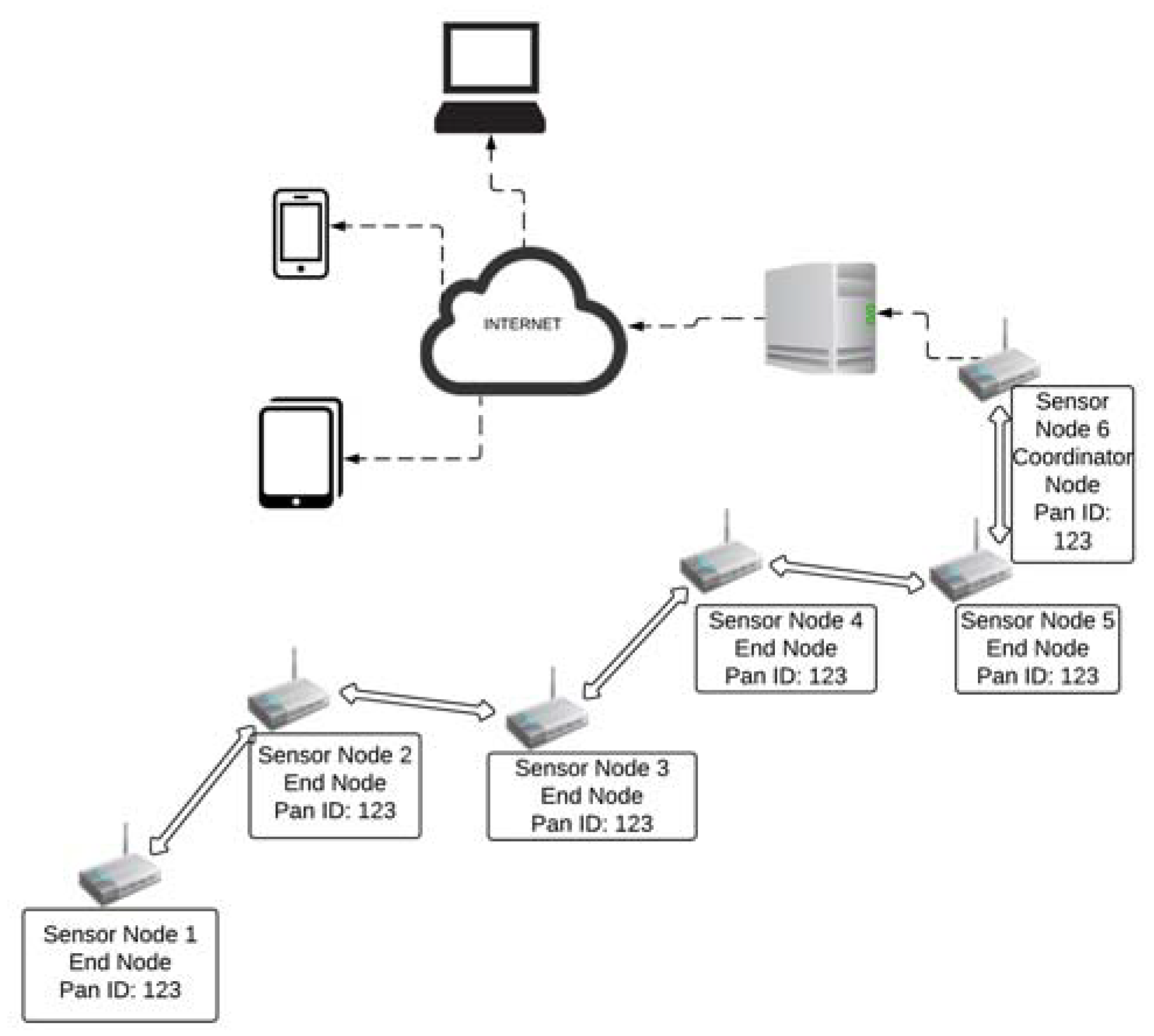
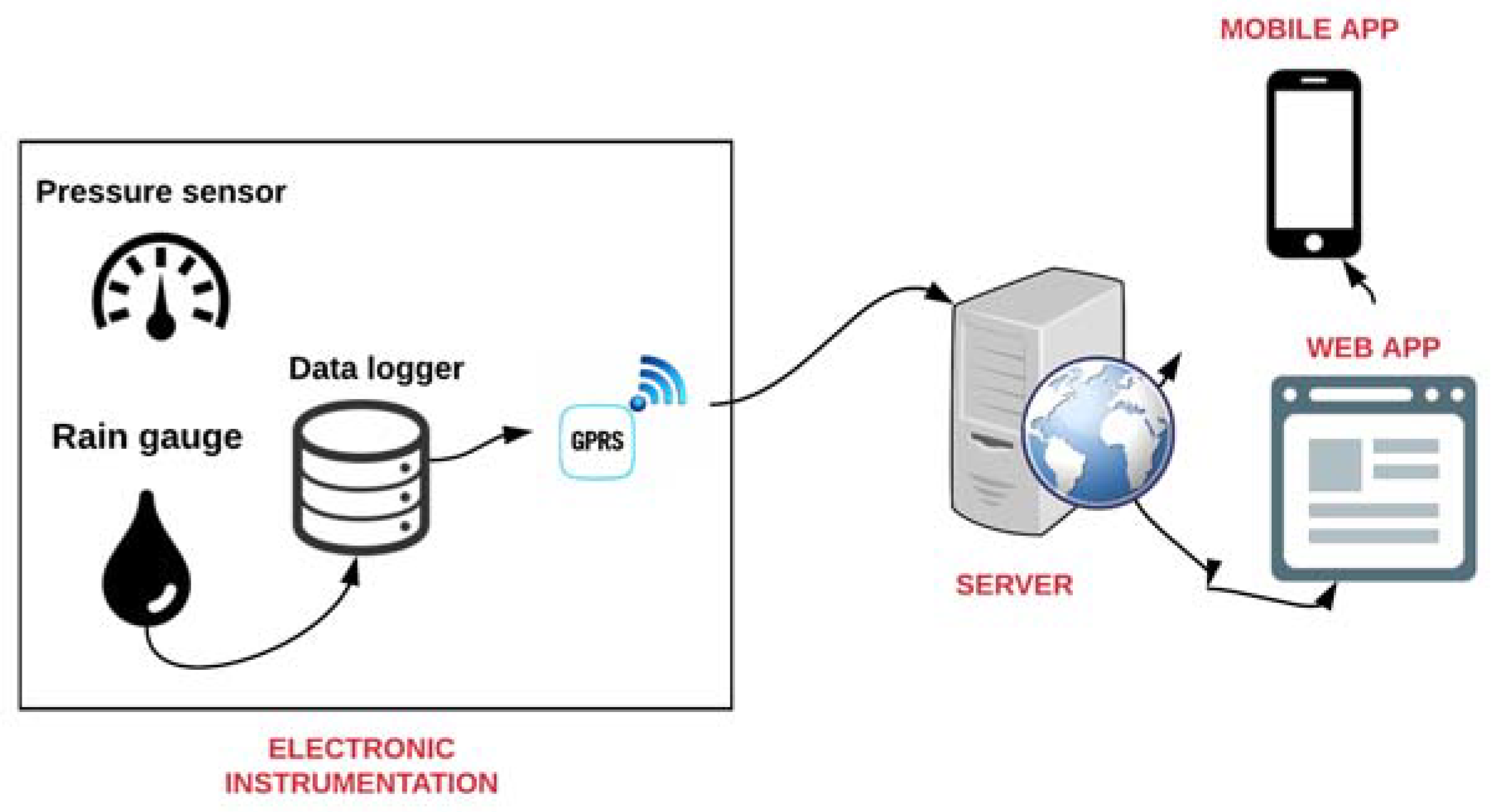
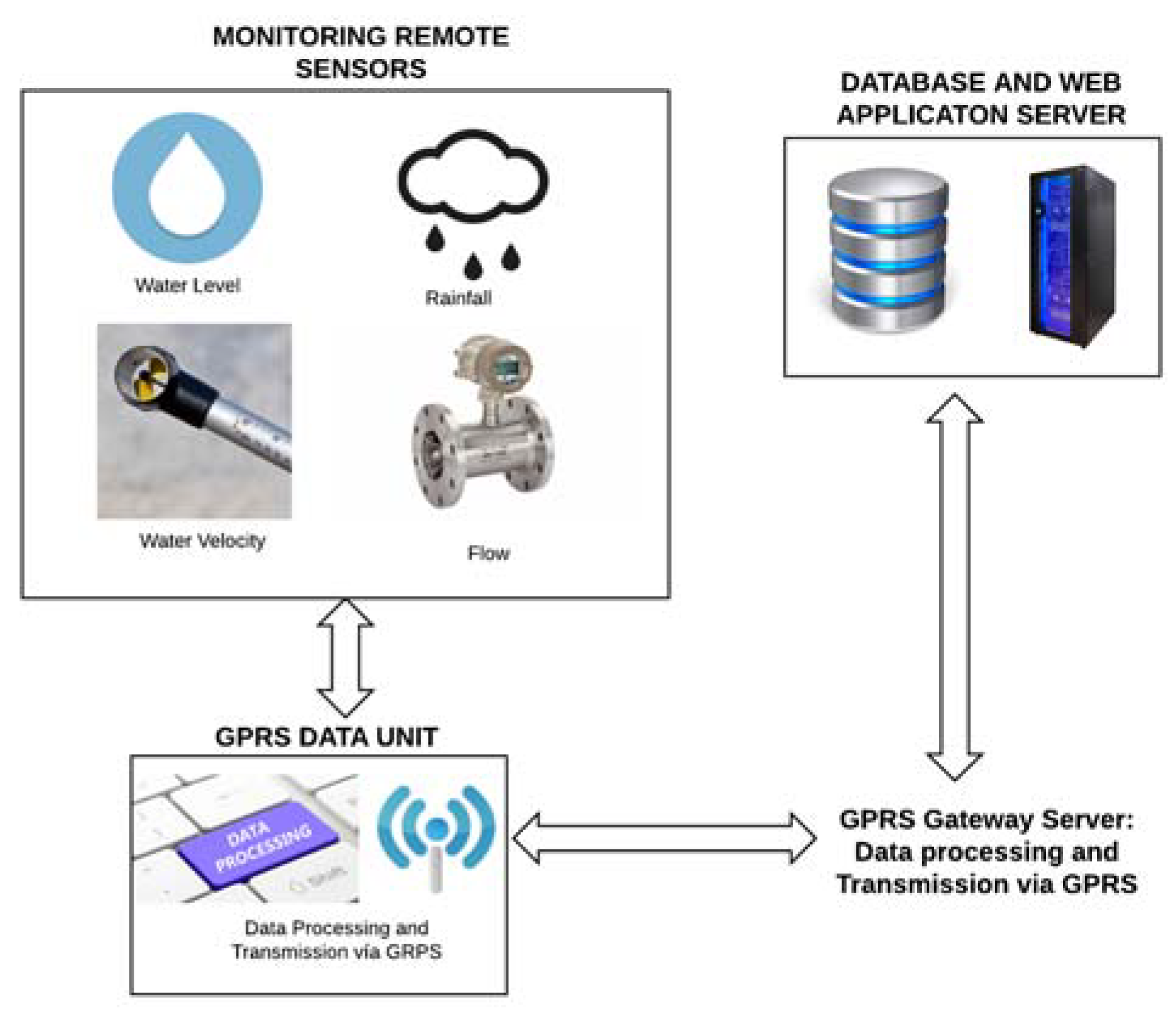
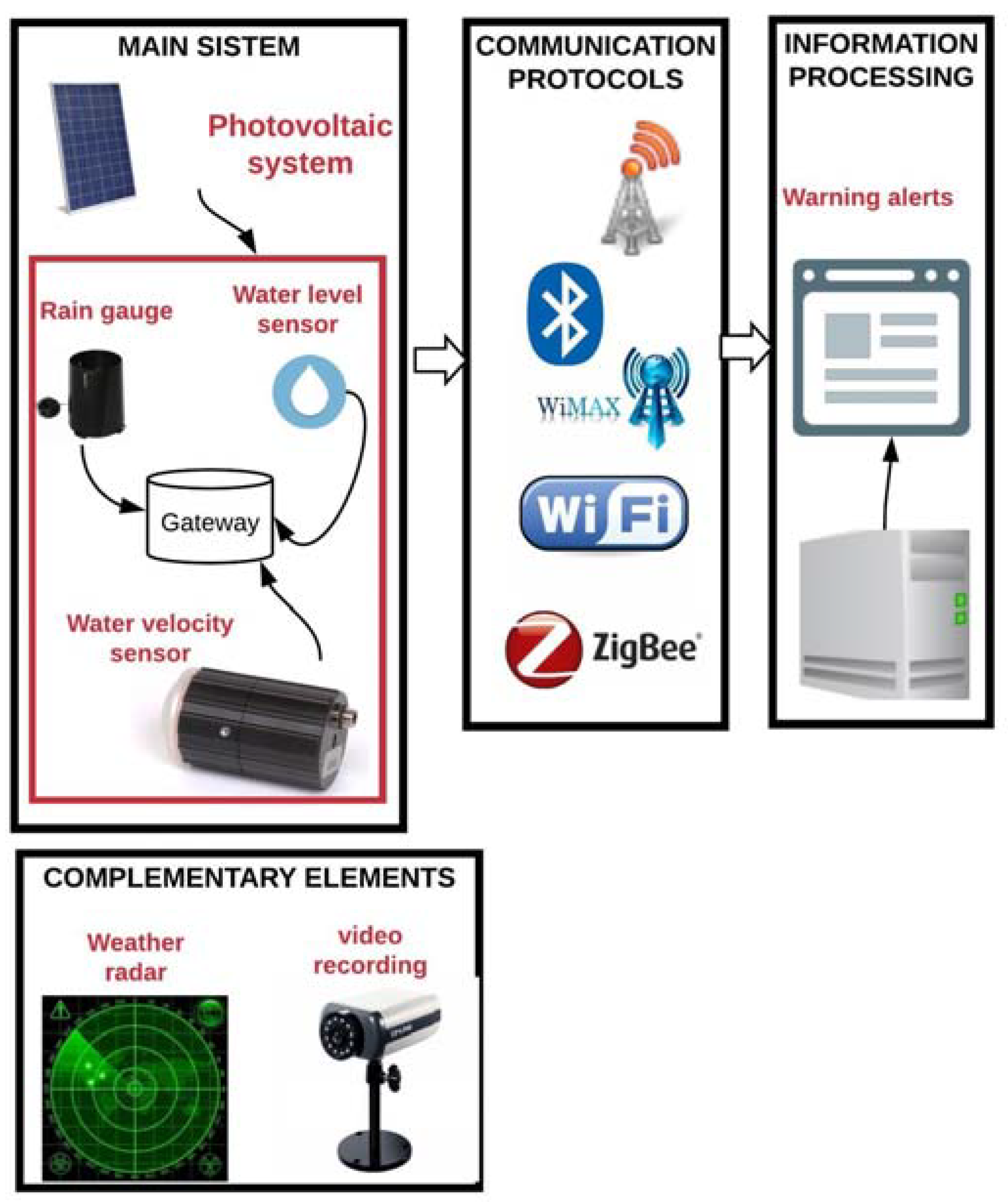
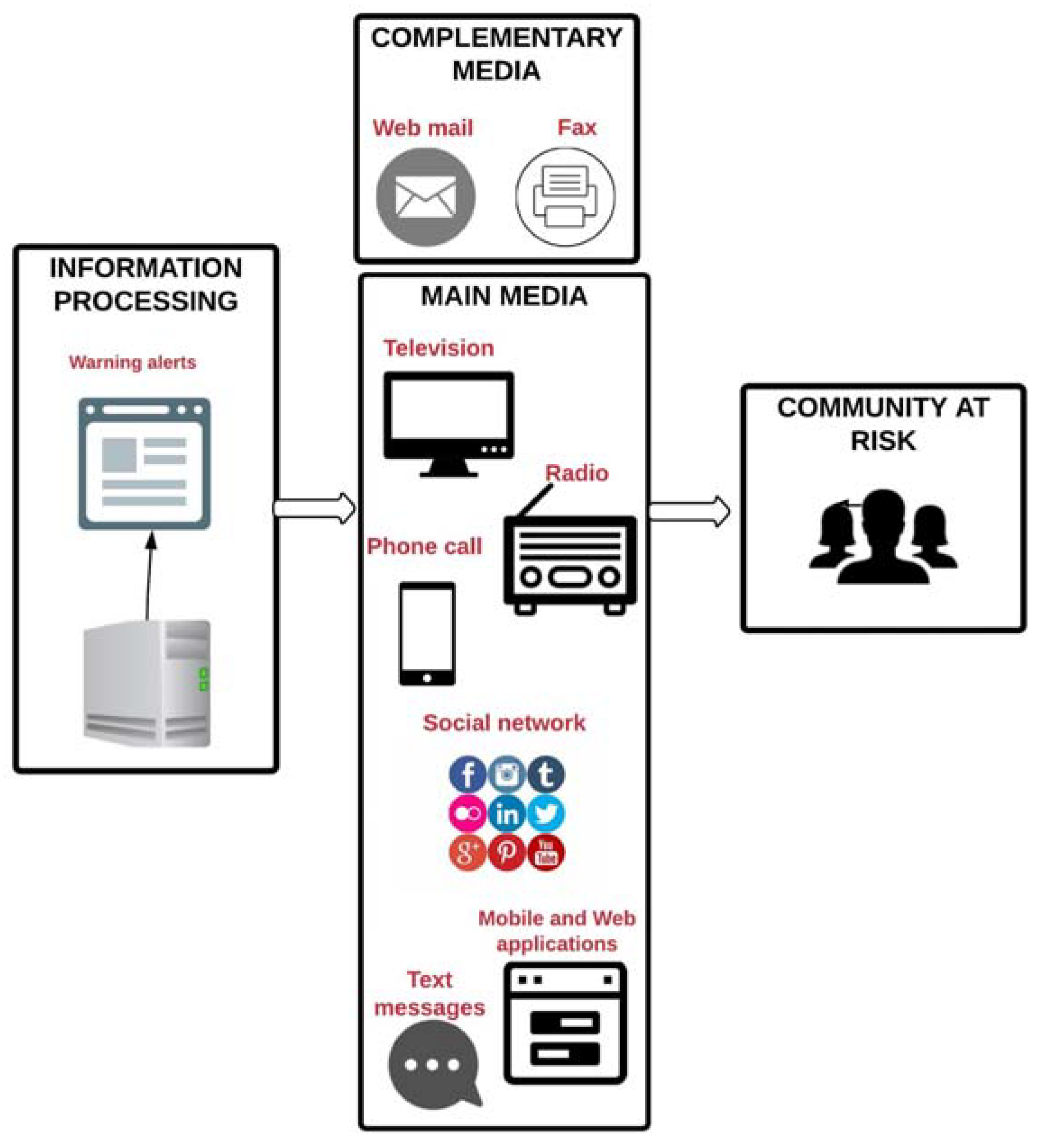

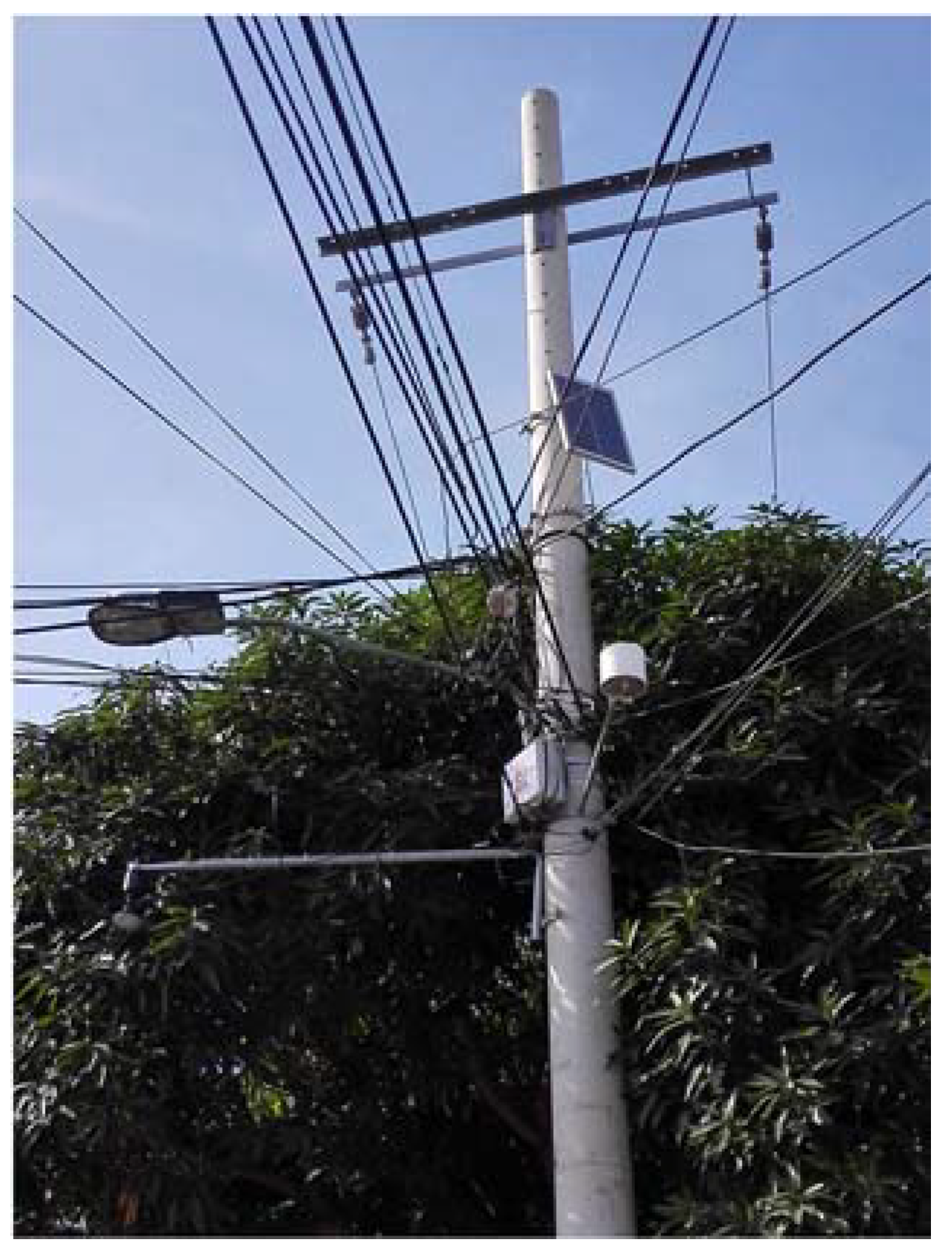
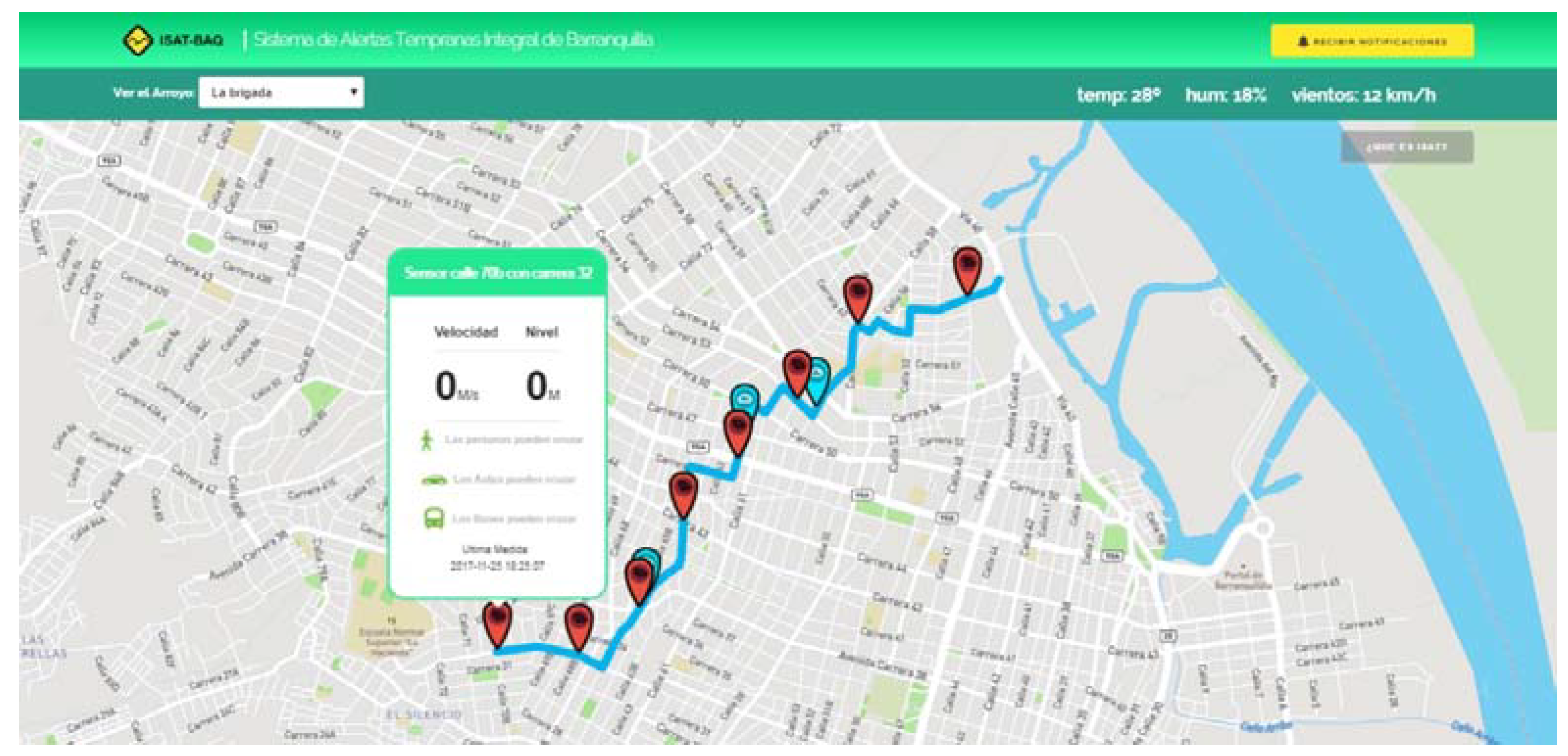
| Source | Population Surveyed |
|---|---|
| Television | 52% |
| 18.9% | |
| 9.6% | |
| Radio | 8.2% |
| News Agency Websites | 6.1% |
| Government Websites | 2.9% |
| Action | % of Respondents | Example Public Response (s) |
|---|---|---|
| Move to a higher location | 84% | “Climb to safety” |
| “Run to higher ground” | ||
| “Get to higher ground and hold on” | ||
| “Climb a tree...” | ||
| “Get to a multilevel building and get to the top” | ||
| “Drive uphill, get out of the car and continue uphill on foot” | ||
| “Get as high as possible” | ||
| Move to a different location | 18% | “Drive to flatland, away from Boulder Creek away from mountains and to higher land” |
| “Run like nuts” | ||
| “Get to nearest safety shelter, hospital, firehouse” | ||
| Avoid risky areas | 12% | “Stay away from creeks + rivers” |
| “Move away from creek areas” | ||
| “Find higher ground away from electric lines” | ||
| Go inside | 10% | “Get inside a strong building” |
| “Go in a commercial building or knock on a door” | ||
| Assess situation | 4% | “Think! Assess the vulnerability of location and act accordingly...” |
| “Determine if the flood will be in your area and take appropriate action” | ||
| “Have high ground picked out nearby and go to it if you see the water and debris coming” | ||
| Be alert | 3% | “Raise alert level and make a plan for possible action” |
| “Be aware of nearby floodways/drainages” | ||
| Seek more information | 1% | “Try to obtain more info about where to go for safety |
| Depends | 7% | “Go to a higher place or leave the area if there is time” |
| “It depends on where you are?” | ||
| Don’t know | 1% | “Honestly, I have no idea” |
| Other | 8% | “Check to hear if it is a practice warning or a real one—then call loved ones and go to a safe location” |
| “Call for help and look for high ground” |
| Key Element | Key Actors |
|---|---|
| Disaster risk knowledge | 1. International, national and local disaster management agencies. |
| 2. Meteorological and hydrological organizations. | |
| 3. Geophysical experts | |
| 4. Social scientists | |
| 5. Engineers | |
| 6. Land use and urban planners | |
| 7. Researchers and academics | |
| 8. Organizations and community representatives involved in disaster management | |
| Forecasting | 1. National meteorological and hydrological services |
| 2. Specialized observatory and warning centres | |
| 3. Universities and research institutes | |
| 4. Private sector equipment supplier telecommunications authorities | |
| 5. Quality management experts | |
| 6. Regional technical centres | |
| Dissemination and communication | 1. International, national and local disaster management agencies |
| 2. National meteorological and hydrological services | |
| 3. Military and civil authorities | |
| 4. Media organizations (print, television, radio and online) | |
| 4. Businesses in vulnerable sectors (e.g., tourism, aged care facilities, marine vessels) | |
| 5. Community-based and grassroots organizations | |
| 6. International and local agencies | |
| Preparedness and response | 1. Community-based and grassroots organizations |
| 2. Schools, universities and informal education sector. | |
| 3. Media (print, radio, television, online) | |
| 4. Technical agencies with specialized knowledge of hazards | |
| 5. International, national and local disaster management agencies |
| Location | Sensors | Communication System | Alert Dissemination | Power Supply | |
|---|---|---|---|---|---|
| Type | Variables to Measure | ||||
| Nakhon Si Thammarat, Thailand | STARLFLOW Ultrasonic Doppler sensor | Water level and velocity | GPRS module | Web application. SMS, FAX, email. | Connected to the electrical grid and UPS |
| Tipping bucket rain gauge | Amount of rain | ||||
| Florida, United States | Ultrasonic sensor WL700 | Water level | Wireless unit (IEEE 802.15) | Online access to raw and predicted data, video information | Photovoltaic system |
| Redeye Z205 Cameras | Ethernet | ||||
| Barranquilla, Colombia | Humidity sensor | Atmospheric variables | ZigBee (IEEE 802.15) | Web and mobile application | Photovoltaic system |
| Temperature sensor | |||||
| Atmospheric pressure | |||||
| Manila, Philippines | Pressure sensor | Water level | GPRS module | Web application | Photovoltaic system |
| Tipping bucket rain gauge | Amount of rain | ||||
| Mayagüez, Puerto Rico | Weather radar | Radar reflectivity and amount of rain | Parabolic antenna (IEEE 802.15) | Web application | Photovoltaic system |
| Barcelona, Spain | Weather radar | Radar reflectivity and amount of rain | Web application, SMS, E-mail | ||
| Protocols | Bluetooth | Ultrawide Band (UWB) | ZigBee/IP | Wi-Fi | Wi-Max | GSM/GPRS |
|---|---|---|---|---|---|---|
| Frequency band | 2.4 GHz | 3.1–10.6 GHz | 868/915 MHz; 2.4 GHz | 2.4; 5 GHz | 2.4; 5.1–66 GHz | 850/900; 1800/1900 MHz |
| Nominal range | 10 m | 10–102 m | 10–1000 m | 10–100 m | 0.3–49 km | 2–35 km |
| Max data rate (Mbit/s) | 0.72 | 110 | 0.25 | 54 | 70 | 0.168 |
| Bit time (μs) | 1.39 | 0.009 | 4 | 0.0185 | 0.0143 | 5.95 |
| Transmitted Power (W) | 0.1 | 0.04 | 0.0063 | 1 | 0.25 | 2 |
© 2018 by the authors. Licensee MDPI, Basel, Switzerland. This article is an open access article distributed under the terms and conditions of the Creative Commons Attribution (CC BY) license (http://creativecommons.org/licenses/by/4.0/).
Share and Cite
Acosta-Coll, M.; Ballester-Merelo, F.; Martinez-Peiró, M.; De la Hoz-Franco, E. Real-Time Early Warning System Design for Pluvial Flash Floods—A Review. Sensors 2018, 18, 2255. https://doi.org/10.3390/s18072255
Acosta-Coll M, Ballester-Merelo F, Martinez-Peiró M, De la Hoz-Franco E. Real-Time Early Warning System Design for Pluvial Flash Floods—A Review. Sensors. 2018; 18(7):2255. https://doi.org/10.3390/s18072255
Chicago/Turabian StyleAcosta-Coll, Melisa, Francisco Ballester-Merelo, Marcos Martinez-Peiró, and Emiro De la Hoz-Franco. 2018. "Real-Time Early Warning System Design for Pluvial Flash Floods—A Review" Sensors 18, no. 7: 2255. https://doi.org/10.3390/s18072255





